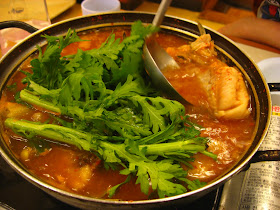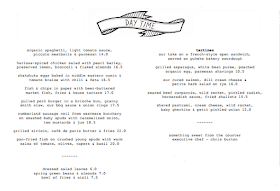Here are a few stories I could tell about our recent trip to Europe, via Seoul...
Seoul: Just One Please
We were at the huge Noryangjin Fisheries Wholesale Market, where, although not hungry, we felt obliged to try the freshest fish possible. We had no idea which restaurant upstairs was good, so when the staff at one place called out "sashimi" (along with some Chinese words of encouragement), we decided to go in. Too late, we discovered that the sashimi would cost around NZ$80, which would probably have been far too much food for us to eat. Instead, we perused the menu and looked for something more suitable for a light meal.
We decided to get a portion of the crab soup, the first item on the menu.
Waitress: Sorry, no.
Us (looking at each other): There's no soup available?
Waitress: Cannot one. Must soup two.
Us: Oh, but we only want one.
Waitress: One, no. Two, OK.
We were pretty bewildered at this. The soup cost something like NZ$25 and we thought it was splashing out a bit already. If you have been to Seoul, you would know that food there is generally pretty cheap, less than its equivalent in New Zealand. What a tourist trap! we thought, silently cursing ourselves for randomly walking into a place like this. We scanned the menu desperately for something more reasonable, but everything was either boring or even more expensive, so we ordered the soup anyway.
Did we just spend $50 on soup? we asked each other. OMG, OMG, OMG, wailed the scrooge in me. But there was nothing we could do. We were there, we had ordered, there was no use worrying about it now.
The complimentary side dishes came out. Not only was it high-quality food, the portions were huge. From a seaweed salad, to silken tofu with a drizzle of sauce on top, to the obligatory kimchi, there was more than we could eat already. Good from a value point of view, not so good when you don't have much of an appetite.
The rice came out, then finally, the soup. Set on a gas burner, it arrived in a giant pot with huge chunks of fish in it, not a crab in sight. And on top, sat a pungent vegetable I knew of as tong ho. Our hearts sank. This was a fail on so many levels. This was surely at least two portions, and there was no way we could finish it. We would be spending a small fortune, and to top it off, we seem to have ordered the wrong soup as well!
 |
| Large pot of Korean fish soup, set on a burner. |
Istanbul: Tale of Two Figs
On our last day in Istanbul (our first destination in Europe), we got up extra early to check out the Inebolu Sunday Market, which according to the Guardian was "an Anatolian culinary carnival located in the downtown grime of Beyoğlu's Kasimpaşa district", a highlight for "genuine Istanbul foodies". The ferry north wasn't running for some reason, and we weren't sure we trusted taking the bus (we had no idea where to buy the tickets, when it would come, or whether we had really been told the right bus number), so we walked the 3 km or so there. (Of course, if we had done our research beforehand, we probably wouldn't have stayed in the touristy Old City in the first place.)
I had expected a major international city like Istanbul to be open all the time, like other big cities in Asia, but as we took the refreshingly cool walk to the market, nearly all the shops we passed were shuttered and closed. Our map led us to what looked like a nondescript little lane, more like a place you could get mugged than a treasure trove of culinary delights, but as we neared, we began seeing people with bags of groceries and finally, some stalls.
It wasn't a large market, with about the same number of traders as the Wesley Community Centre Market (a.k.a. Sandringham Market) here, but with smaller quantities of everything. I admired how huge the heads of cabbage were, and how rustic the sellers made the eggs look, sitting in hay in woven baskets. There were various forms of breads, olives, cheeses and jams, as well as fresh fruits and vegetables. I wish I had tried harder to learn basic Turkish, as I would have loved to have found out more about the various products.
Since we were planning to leave that day, we couldn't go on a shopping spree. But I also didn't want to leave empty-handed. I decided to buy a couple of figs to try—if Turkish tomatoes were anything to go by, these would be packed with flavour and an absolute joy to eat.
Me (holding up two fingers, then pointing at the pile of figs): I'd like two figs, please. How much would that be?
Seller (holding up four fingers): Dört lira. Four lira.
Wow, that's pricey, I thought to myself, but, well, no worse than if I'd bought them in New Zealand. Maybe they are particularly delicious. I handed over the money.
The seller put a handful of figs into a bag, then another handful. And that's when I realised that I had purchased two kilos of figs, rather than just two. I considered stopping him at one kilo, but as I had already paid for the full amount, and it would be too hard to explain anything in my non-existent Turkish, I waited, took the bag with a smile, and thanked him. I gave away a lot of figs that day.
 |
| Quite a few more than two figs. |
We found ourselves at a restaurant close to our hotel in Rome one evening, without having researched what the tipping etiquette was in Italy. The service had been friendly and the food excellent, so we decided to play it safe and err on the side of tipping too much, giving the waiter an extra 10% above the price on the bill. It wasn't until we got back to our hotel and had internet access that we realised that this was 10% too much, as service is already included in the form of coperto.
The next evening, we returned to the restaurant as we had promised the waiter we would. This time we were welcomed with a bubbly aperitif to begin, before we had even decided on what to order. The tomato and mozzarella bruschetta we chose to share as an entree was clearly up-sized when it came out, with each of us receiving our own plate.
After another delicious meal, we couldn't bear to skip dessert. We ordered the tiramisu as recommended, and for those who needed something lighter, simply pineapple and icecream. Except it wasn't simple-looking at all. We didn't know if this was how pineapple was normally served, but we were very impressed with being presented an elaborately-cut wedge of the fresh fruit, complete with leaves on top and the fibrous centre pinned back with a toothpick to reveal the sweet flesh laid out in a zig zag pattern. The accompanying ice cream flavours were a delightful selection of chocolate, hazelnut and coffee, topped with a swirl of whipped cream.
 |
| Italian pineapple and ice cream dessert. |
Well, that sealed it. We certainly couldn't reduce our tip this time. We may have paid a little too much, but for all the freebies and the royal treatment, it was definitely worth it!
Dresden: Once or Twice?
Our hotel in Dresden had warned us that everything would be closed on 3 October, because it was a national holiday. On the German Unity Day (Tag der deutschen Einheit), the receptionist claimed, none of the supermarkets and practically none of the restaurants will be trading. We might find some tourist attractions still open, but be prepared!
This was disappointing news indeed, as we had only planned to spend one day in this beautiful city. Fortunately, it was not as dire as she had made it out to be. We had no trouble visiting the eye-raisingly amusing Hygiene Museum or the Volkwagen Transparent Factory (where we were the only visitors on the English tour), nor did we have any difficulty finding food to eat. In fact, there was a Herbstmarkt, or autumn market, in the old market square right next to our hotel.
As you might imagine, there were plenty of stalls selling sausages and beer. There were also rides for the children, from a mini train to a ferris wheel. Sweet treats included gingerbread hearts with words of love on them (I was surprised there were also messages in Russian, until I remembered we were in East Germany), French crêpes, and round doughnuts called Quarkkrapfen, which you can have either as is (ungefüllt), or filled with either jam (Marmelade) or eggnog (Eierlikör).
 |
| Fried quark ball filled with German eggnog (Quarkkrapfen mit Eierlikör). |
 |
| Large pans of food cooking: soljanka (left) and kale stew (right). |
Us: Sure.
Lady (adding fried potatoes, then placing a sausage on the kale): Mustard?
Us: Yep, great.
Lady: Once or twice?
Us (confused): Does she mean one or two sausages, or one or two squirts of mustard? Oh, twice, please.
 |
| Kale with smokey sausage from the Ore Mountains, fried potatoes and mustard (Grünkohl mit erzgebirgischem Knacker, Bratkatoffeln, Senf). |































